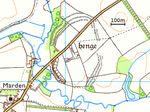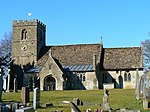Wiltshire (; abbreviated to Wilts) is a ceremonial county and historic county in South West England. It borders Gloucestershire to the north and the north-west, Oxfordshire to the north-east, Berkshire to the east, Hampshire to the south-east, Dorset to the south, and Somerset to the west and the south-west. The largest settlement is Swindon, and Trowbridge is the county town.
The county has an area of 1,346 sq mi (3,490 km2) and a population of 720,060. The county is mostly rural, with the centre and south-west sparsely populated. After Swindon (183,638), the largest settlements are the city of Salisbury (41,820) and the towns of Chippenham (37,548) and Trowbridge (37,169). For local government purposes the county comprises two unitary authority areas: Swindon and Wiltshire.
Undulating chalk downlands characterize much of the county; the North Wessex Downs in the east, Salisbury Plain in the centre and Cranbourne Chase in the south. The north-west is part of the Cotswolds, a limestone area. The county's major rivers are both called the Avon: the northern Avon enters the county in the north-west and flows in a southwesterly direction before leaving it near Bradford-on-Avon; the southern Avon rises on Salisbury Plain, flows through Salisbury and then into Hampshire.
Salisbury Plain is noted for the Stonehenge and Avebury stone circles, which together are a UNESCO World Heritage Site, and other ancient landmarks. Much of the plain is a training area for the British Army. The city of Salisbury is notable for its medieval cathedral. Large country houses open to the public include Longleat, where there is also a safari park, and the National Trust's Stourhead.










